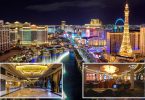Special Report: As President Donald Trump vows to “get Greenland,” direct flights from the U.S. are starting up for the first time. What kind of reception will Americans get?
ILULISSAT, Greenland − Much like the luminous and shape-shifting ice sculptures that dominate every sightline in this craggy Arctic Circle town, Greenland’s tourism industry is ever expanding, breaking off into new formations, floating past a window. And, for now, both tuning out President Donald Trump and preparing to host more Americans.
How’s that going to land − for everybody?
In Ilulissat, Greenlandic for “icebergs,” a new airport is being built for large transatlantic aircraft. Towering construction cranes dot the rocky promontory on which the town − population 5,000 − sits. Fishing boats and tour operators zip in and out of a busy harbor fronted by a state-of-the-art shrimp peeling and processing factory. There’s a plan afoot for another new hotel that will look out over waters full of the seal, whale and narwhal that congregate around Qeqertarsuaq, or Disko Island, the world’s largest island’s largest island.
But while Trump himself has not traveled to Ilulissat despite his pledge to “get Greenland” from Denmark for national security reasons, more Americans almost certainly will. On June 14 − Trump’s birthday − United Airlines will begin direct U.S.-Greenland flights, making it far easier for them to visit a place their president says the U.S. will acquire “one way or the other.” Never mind that Greenlanders and their ultimate political masters in Copenhagen have made it clear they aren’t buying whatever it is Trump is selling when it comes to his Greenland overtures.
“We don’t care where our visitors come from,” said Ulrik Amdi Sørensen, manager of Hotel Arctic, a sprawling site with lodgings, two restaurants and conference rooms perched on a hillside with views of Ilulissat Icefjord.
The icefjord is a UNESCO world heritage area, meaning it has cultural, historical or scientific significance that gives it legal protections. It is the “sea mouth” of Sermeq Kujalleq, a glacier in western Greenland about 155 miles north of the Arctic Circle. Its ice sheet produces around 10% of Greenland’s icebergs. As far as glaciers with reputations go, it has one: In 1912, an iceberg chunk “calved” from the face of Sermeq Kujalleq drifted out to sea, appeared out of the mist and slammed into the Titanic on its disastrous maiden voyage.
Greenland gets closer to the U.S.
United’s flights will go to Nuuk, Greenland’s capital, about 350 miles south of Ilulissat. Nuuk opened its own expanded international airport in 2024, enabling Trump’s eldest son, Don Jr., to land there on his father’s “Trump Force One” private plane for a day trip in January. That visit unsettled locals because of the president’s Greenland comments.
They were also offended when they saw members of Donald Trump Jr.‘s entourage hand out $100 bills, food and “Make Greenland Great Again” hats to homeless people to lure them to an event. A few months later, Vice President JD Vance and his wife Usha confined a planned Greenland visit to a remote Arctic military base after it became apparent Greenlanders didn’t want to speak with them − not least because they arrived during an election.
However, Ilulissat and its icebergs are Greenland’s biggest tourist draw. Scientists classify their shapes as “tabular,” “sloping,” “pinnacled,” “dry-docked” and “blocky,” among other descriptors. To the untrained eye, they resemble anything from a pancake to a herd of elephants; from a spiky skyscraper to a blob of the classic Italian dessert tiramisu. Icebergs can be blue, yellow, black. They can even look like striped candies.
Like characterizing an iceberg, it’s difficult to precisely pinpoint how many Americans are currently traveling to Greenland. According to Visit Greenland, the territory’s tourist agency, about 145,000 tourists overall visited in 2024, the majority of them arriving on large cruise ships. Most stay ashore for only a few hours at a time. In 2024, just over 4,700 travelers from North America stayed overnight in a hotel room in Greenland.
What’s clear, said Tanny Por, who directs Visit Greenland’s international marketing and promotion efforts, is that Greenland has received a lot more attention “for many different reasons in the past six months.” She cited the new airports, United’s direct flights and also coming direct flights from Copenhagen to Nuuk with Scandinavian Airlines.
Por said it was too early to gauge how Trump’s interest in Greenland has impacted bookings for Americans.
Still, Hotel Arctic’s Sørensen estimated just 5% of guests at his hotel in a typical year come from the U.S. He expected that to increase because of the new flights to Nuuk, Ilulissat’s airport expansion scheduled to finish in 2026 and because, well, because Trump has effectively helped put Greenland “on the map.”
Sørensen also acknowledged the attention Trump has brought to Greenland, shaking its relative Arctic anonymity, is weighing on the minds of some of his guests. “Most of the Americans who have stayed with us this year have immediately told us when they arrive: ‘We don’t support Trump,'” he said.
In Nuuk, a boutique named Outdoor Greenland recently sold out of a T-shirt it with the phrase “Greenland Is Not for Sale” emblazoned on it. On a recent afternoon, a young woman working in the store said the item proved hugely popular with tourists and Greenlanders alike.
“I guess they served their purpose,” said Nora Gelskov.
Trump pledges to ‘get Greenland’ as direct flights from US start
As Trump vows to “get Greenland,” direct flights from the U.S. are starting. What reception will Americans get?
A visitor in disconnected Greenland
Greenland’s cities, towns and settlements are not connected by road.
The only way for tourists to move around is by boat, plane or helicopter.
If visitors make it to Ilulissat during Greenland’s summer season, which typically runs June through August, they will find a place that, to outsiders, retains the feel of a rugged frontier town.
Workers in overalls walk down dusty streets that turn into dusty tracks before petering out to nowhere. Houses are made of wood and painted bright shades of red, yellow or blue. They are built directly on top of rocky terrain, with their waste and water pipes exposed. There’s no high school.
Zion’s Church, erected in the late 18th century and once the island’s largest building, is now probably the most photographed church in all Greenland. On a recent afternoon − Or was it 3 am? It’s hard to sell when the sun never sets − its steep-pitched roof and dark-brown wooden facade solemnly stared out at Disko Bay’s glittering icebergs.
A reporter counted three supermarkets in Ilulissat. In addition to Danish chocolates, meat and dairy products, and a sprinkling of well-traveled summer fruit, they sell power tools, car oil and various gear that looked like it could prove useful on a seal, whale or caribou hunt, a normal feature of life for Greenland’s Inuit communities.
They make up almost 90% of the island’s 57,000 inhabitants.
Greenland: icebergs vs. dogs
Still, if icebergs dictate Ilulissat’s visual landscape, dogs are in charge of how it sounds. (Icebergs also make noise.)
Dog sledding has been a part of the Greenlandic identity for thousands of years.
In winter, dogs are used for hunting, fishing and to travel between settlements. In Ilulissat, there’s an estimated 2,200 husky-type sled dogs − nearly one for every two humans.
Throughout the day − also at night − Ilulissat’s dogs could be heard howling, barking in a squeaky high pitch and generally carrying on from the fields and hillsides on the town’s edge where they are kept. They sat around, frolicked, snoozed, wondered about their next meal, and licked pups or themselves.
“People ask us: Why do you still keep dogs?” said Flemming Lauritzen, who set up Arctic Living Ilulissat, a dog sledding center that runs tours and educational activities, with his wife Ane Sofie.
“I tell them: ‘Imagine sledding into the mountains in December,'” he said.
“‘It’s dark. A full moon. Newly fallen snow. Maybe the Northern Lights are there. When you arrive at your spot, you overlook the whole ice sheet shining like a sugar bowl. The only sound is of the dogs’ breath. Magical.'”
Dog sledding in retreat
Dog sledding, according to the Lauritzens, is also slowly vanishing.
Among the threats: fuel-efficient snowmobiles; a changing climate melting the ice and shortening the season; and infrastructure development for tourists, which erodes available land where the dogs are kept.
Thirty years ago, there were 30,000 sled dogs in Greenland. Now there’s half that.
“We are not opposed to tourists. The people that fly in, they’re not the problem − Americans or anyone else,” said Ane Sofie, speaking inside a cosy wooden cabin the couple built to receive visitors at the center.
On the walls were maps detailing their expeditions and traditional Greenlandic cold-weather garments made from animal hide and fur. Outside, about 30 of their dogs munched on dinner: fish scraps.
“It’s the cruise ships,” she added. “People get dropped off in our little town, buy a lot of the food and goods in the supermarkets, which means people like us often can’t get the essentials we need.”
Destination Greenland?
Jens Lauridsen is the CEO of Greenland Airports, the government-owned operator of the territory’s 13 airports.
After United announced in October 2024 it would be flying to Nuuk, Lauridsen was quoted in a company press release saying the move would “significantly enhance Greenland’s visibility on the global stage.”
Lauridsen was almost right. Trump got there first. He has done much of the heavy lifting.
In an interview, Lauridsen said he is confident the United flights would “grow tourism from North America” despite the recent political backdrop. He believes most Greenlanders “see a benefit from tourism,” though it represents a relatively small part of Greenland’s economy compared to fisheries and a grant from Denmark, the largest inputs.
“The question is how fast it develops,” he said.
Senior members of Greenland’s government, tired or perhaps just wary, of talking about Trump’s Greenland obsession declined an opportunity to comment. But Kuno Fencker, an opposition lawmaker who wants Greenland to become independent from Denmark as soon as the conditions are right, said he believes the government made a mistake by choosing not to expand of all Greenland’s airports, focusing only on the ones in Nuuk and Ilulissat.
“Of course we want more tourists. We also want to diversify our economy,” he said.
A spokesperson for United declined to reveal how well its flights to Nuuk have sold.
‘A real Danish beer’: The Americans are already here
USA TODAY came across few Americans in Greenland over the course of a week. One couple, off a cruise ship they boarded in Baltimore, made a brief stop at a Nuuk hotel because they wanted to get a “real Danish beer.” Another, from Oregon, made a last-minute decision to fly to Nuuk from Iceland, where they had been vacationing.
Both couples said they found the scenery stunning, Greenlanders polite and friendly, and thought many Americans would agree. However, they wondered if recent geopolitics might dissuade some potential visitors.
‘Yeah I don’t know. Maybe’
In one sense, Americans have already made their mark in Greenland.
So have Jamaicans.
On a recent day, Arnaq Bourup Egede was at work in an Ilulissat store called “Malibu,” named after the strip of beaches near Los Angeles. Malibu the store sells a Greenland-designed urban-and-sports-wear label called “Bolt Lamar,” a joining of the names of Jamaican sprinter Usain Bolt and U.S. musician Kendrick Lamar.
“Yeah. I don’t know. Maybe,” Egede said in response to a reporter’s question about whether she wanted more American tourists to show up in Greenland, and whether she viewed them as a boost, a burden or neither.
In terms of land mass, Greenland is enormous, equivalent to three Texases. It’s also a small place. Egede plays for Greenland’s women’s national soccer team when she’s not working in the store. Her brother is Greenland’s former prime minister, Múte Bourup Egede.
Egede paused. She thought about the question some more. She likes reggae music. A large picture of the Jamaican star Bob Marley leaned on an upper shelf near the register. Bob Marley and the Wailers’ 1977 song “Waiting in Vain” played on the stereo.
“I’m not against American tourists,” Egede finally said. She added that there were other branches of the business she worked in spread across Greenland’s cities. They were called “California,” “Miami” and “Alaska.”
Kim Hjelmgaard in an international correspondent for USA TODAY. Follow him on Bluesky, Instagram and LinkedIn.
Contributing: Jennifer Borresen










